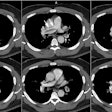AJR Am J Roentgenol 2002 Nov;179(5):1205-8
Clinical usefulness of imaging performed after CT angiography that was
negative for pulmonary embolus in a high-risk oncologic population.
Ginsberg MS, Oh J, Welber A, Panicek DM.
OBJECTIVE: The purpose of our study was to determine the prevalence and types of
additional imaging examinations that were performed, and whether anticoagulation
therapy was started or continued, after CT angiography showed no pulmonary
embolus in a high-risk oncologic population. MATERIALS AND METHODS: We reviewed
the radiology report for each CT angiogram that was obtained for clinically
suspected pulmonary embolism at our institution (a tertiary cancer center)
during a 25-month period. The radiology information system was then searched for
any additional confirmatory radiologic examinations performed within 2 days
after a negative finding on CT angiography. Medical records were reviewed to
determine whether anticoagulation therapy was started or continued despite a
negative finding on CT angiography. RESULTS: Two hundred seventy-six CT
angiograms were obtained in 260 oncology patients who were clinically suspected
of having pulmonary embolism. The findings from 203 CT angiograms (74%) were
interpreted as negative; 56 (20%), as positive; and 17 (6%), as equivocal for
pulmonary embolism. Fifty-eight patients (21%) with negative findings on CT
angiography subsequently underwent additional imaging, the results of which were
potentially clinically important in 6% of the patients. Six patients began to
receive and two continued to undergo anticoagulation therapy despite negative
findings on CT angiography; three of the six patients received anticoagulation
for new-onset atrial fibrillation. CONCLUSION: Negative results of CT
angiography for pulmonary embolism did not deter referring physicians from
ordering other confirmatory imaging tests in 21% of patients in a high-risk
oncologic population. Those additional tests rarely revealed results that might
have been clinically important.







